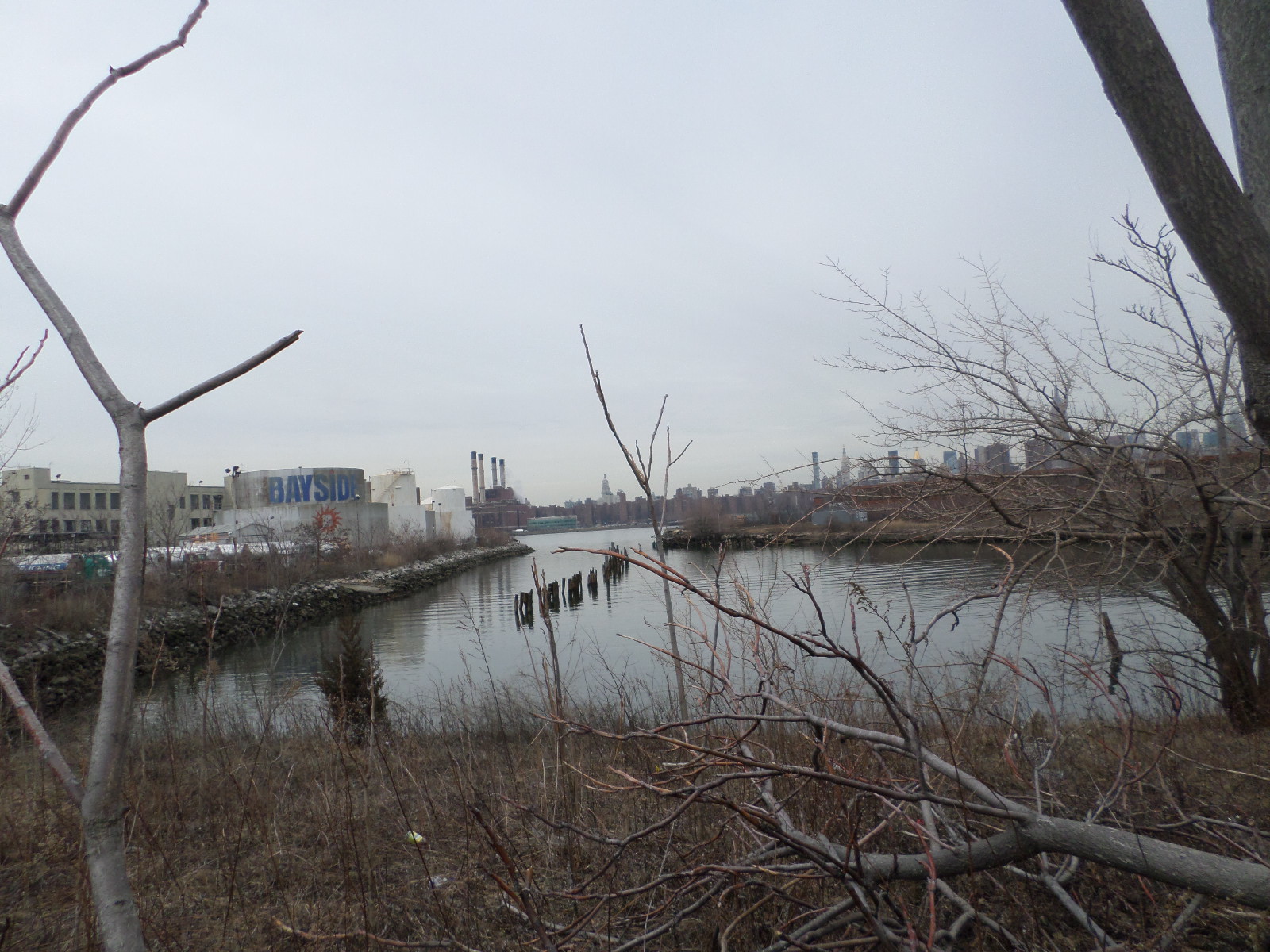Education Isn't Either/Or
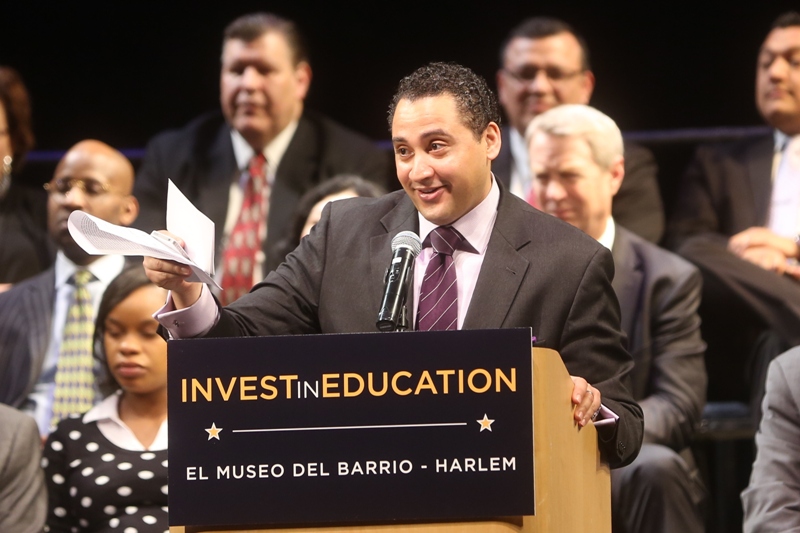
Assembly Member Rodriguez, the author (photo: investined.org)
Each year education advocates head to Albany to fight for our children, this year was no different as thousands arrived on the steps of the Capitol last week clad with signs, flyers, and banners. Yet, among all the differences, all the arguments they bring to the table, one thing is clear – our children need our help.
There are a bounty of choices for parents: public schools, charter schools, private and parochial schools; I hear the benefits of each and we feel the successes of their graduates in our community. There are a million reasons to choose one over another, but the choice is limited if they don't receive adequate funding to stay open.
There are 143,000 children, the majority of them children of color from low-income neighborhoods, stuck in failing schools that are crippled by a lack of basic resources, including equitable funding. The $1.8 billion increase in school funding put forth by Assembly Speaker Carl Heastie, myself, and my colleagues will fill the Gap Elimination Adjustment and start meeting the $4.9 billion Campaign for Fiscal Equity (CFE) commitment we so badly need to keep schools funded.
It's simple to fix this problem by allocating more money in the budget for schools through tax proposals - we already have a school system that has been hurt by property tax caps. However, dedicating a larger portion of the State's bank settlement funds towards CFE will allow us to make the needed improvements to our schools.
As we fight for what we deserve from the CFE settlement, we must also explore education reforms. Funding and improving our schools must not be an either/or conversation; we should willingly implement reasonable changes that provide the best results for our kids.
First, we must ensure adequate funding for quality pre-Kindergarten programs. Pre-K is integral in identifying and helping special needs students early in the educational process. The ability to detect special needs early will allow parents to work with teachers to identify the best course of action to ensure their child gets the help they need and can potentially eliminate their need to be enrolled in special education (SPED) to begin with.
Second, we need to reevaluate our SPED programs. African-American and Hispanic children are more than twice as likely as their white counterparts to be identified by teachers as having serious learning disabilities, and they are 1.5 times more likely to be funneled into SPED services than all other racial and ethnic groups combined.
In New York City, district schools receive an extra $2,309 to $8,609 per SPED student, and often even this is insufficient. Further, If a school graduates a student out of SPED status and provides only supplemental support, the extra school aid drops to just $500, creating a disincentive for schools to graduate students from SPED. While there are schools, both district and charter, which do serve special needs students, and serve them well, many do not. We should increase special education funding for students who can be in mainstream classrooms but need additional services, eliminating the disincentive to move students out of SPED.
Third, we need to explore what accountability looks like through fair and unbiased evaluations. Our teachers can't be portrayed as villains, they are our greatest ally in ensuring our children get the best education.
Last, where teachers and principals have been found to have committed a violent crime, been involved in misconduct involving the sexual abuse of a student, or found incompetent through a pattern of ineffective teaching, a swift suspension or removal process must be implemented to protect our children. Lengthy processes hurt our schools' abilities to educate our children and thus hold our students back.
As we work toward a budget that includes what is owed us from the CFE lawsuit, we must not ignore the areas where we can learn and enhance the opportunities we provide to our children. Our educators and communities, our teachers, our district schools, our charters, and ultimately, our students, have too much on the line to ignore the necessity for bold action, structural improvements, and needed investments to end our state's failing school crisis.
***
Assembly Member Robert Rodriguez represents East Harlem/El Barrio and the Upper East Side.
***
Have an op-ed idea or submission for Gotham Gazette? E-mail editor Ben Max: This email address is being protected from spambots. You need JavaScript enabled to view it.
New York Colleges Need the DREAM Act
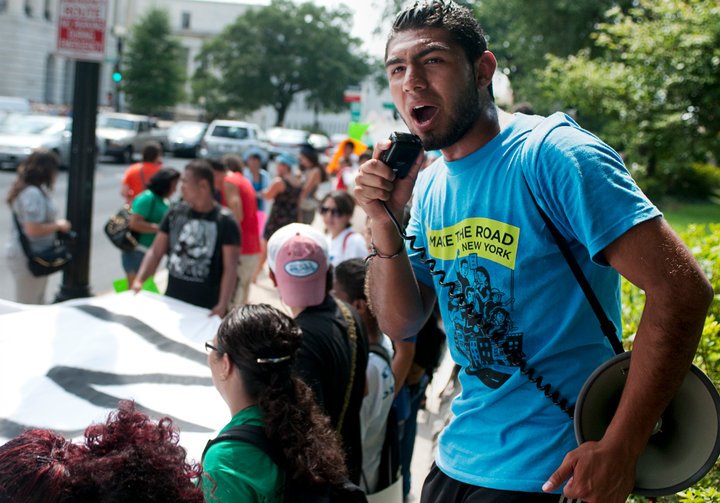
Francisco Curiel, one of the co-authors
Queens College is a special place. As one of the country's most culturally diverse campuses—we serve men and women from more than 150 countries—the college seeks to "prepare students to become leading citizens of an increasingly global society," as our mission statement notes. We pride ourselves on being accessible and offering a rigorous education. In keeping with our motto—"We learn so that we can serve"—we provide an education that will enable our graduates to better serve their communities and the needs of our beloved New York State.
We strive to make Queens College as accessible as possible to all New Yorkers who meet our high admissions criteria. But there is a major roadblock confronting many DREAMers (undocumented immigrant students). The roadblock is that, because of their status, DREAMers are ineligible for financial aid.
All of New York State's colleges and universities would benefit from the passing of the DREAM Act. Its passage would open up the state's Tuition Assistance Program (TAP) to DREAMers who meet TAP's eligibility criteria. We would also be better able to achieve our goal of educating all New Yorkers and putting them on the path to high-skilled employment.
There are three main reasons why the DREAM Act should be passed immediately. First, the DREAM Act would open the doors of educational opportunity to thousands of students who otherwise would be unable to earn a college degree. This would be life changing for these young people and their families. The DREAM Act would also benefit immigrant youth who already are on campus. One of us (Mr. Curiel) is an undocumented youth and a Queens College student who maintains good grades and participates in campus life. However, he has no access to state-funded financial aid, which means significant financial strain on his family, as it does on thousands of other New York families.
Second, the DREAM Act could further advance academic excellence on our campuses. Numerous studies show that all students benefit when they are part of a diverse student body. Queens College students benefit from the rich exchange of ideas and experience that occurs in our classrooms, cafeterias, and common spaces among students from different backgrounds—whether those be national origin, race, culture, ethnicity, or sexual orientation. Having more DREAMers on our campuses would further invigorate classroom discussions and campus life, benefiting DREAMers and non-DREAMers alike. It could also help DREAMers feel more comfortable on campus by eliminating the arbitrary barrier that immigration status can sometimes impose.
And third, the DREAM Act would enable us to fulfill our mission of educating all New Yorkers and developing a skilled workforce grounded in a liberal arts and science education. In today's global economy, it is essential that we develop an educated workforce to keep New York State ahead of its competition. To do this, we must ensure that every qualified young person who wants to go to college can do so.
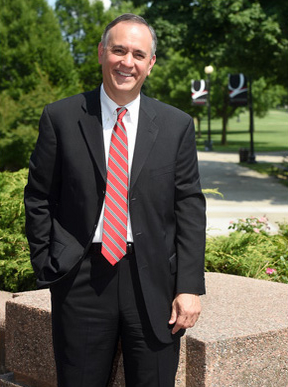
Queens College President Matos Rodriguez
A report by the Office of the State Comptroller (OSC) found in 2014 that "the short-term costs of extending financial assistance to undocumented students would be outweighed by the long-term economic benefits." Having more DREAMers in our colleges would significantly increase the ranks of high-skilled workers contributing to our state economy. It would also strengthen our state's tax base, as the OSC found that "a person earning a bachelor's degree would pay more than $60,000 in additional State taxes, compared with a maximum TAP award of $20,000."
In short, the DREAM Act makes sense on three fronts: expanding educational access to New York's youth, enriching our campus life, and benefiting our state economically and socially.
The only challenge now is the willingness to act. By passing the DREAM Act, New York State would be standing up for its talented immigrant youth. It also would be standing up for the continued excellence and vibrancy of our higher education institutions. These are goals we can all support.
****
by Félix V. Matos Rodríguez and Francisco Curiel. Matos Rodríguez is the President of Queens College; Curiel is a Queens College student and a Youth Power Project member of Make the Road New York.
***
Have an op-ed idea or submission for Gotham Gazette? E-mail editor Ben Max: This email address is being protected from spambots. You need JavaScript enabled to view it.
Legitimacy of City Land Use Process at Stake in Brooklyn Park Problem
The Bushwick Inlet (photo: Janos Marton)
I think there is zero chance of developers walking away from this waterfront. Look at this view! This is the best view in New York City, maybe in the whole world. You've got the entire Manhattan skyline right in front of you. - Council Member David Yassky (Williamsburg/Greenpoint), 2005
In Williamsburg and Greenpoint, luxury condos have been popping up like mushrooms after the rain. Yet ten years after North Brooklyn was promised a 28-acre park on the East River, that park's prospects seem as remote as ever, in danger of slipping away for good. Recently, neighborhood groups have revived the clamor for Bushwick Inlet Park. At stake is not only greenspace for a community that desperately needs it, but the fundamental legitimacy of the city's land use policy. In 2005, Williamsburg/Greenpoint underwent an enormous rezoning, allowing today's luxury buildings. That rezoning came with a promise from the city, and if the city cannot deliver Bushwick Inlet Park, New Yorkers should not trust the city when it comes to rezone their neighborhoods.
Some New Yorkers think of Williamsburg as a gentrified monolith, but it is full of working class communities that have been there for decades: Polish and Italian on the North Side, Puerto-Rican, Dominican and Hasidic on the South Side. These cultural groups have clashed a great deal over the years, but little has brought them together like waterfront development, long blocked off to all of them by heavy industry.
Activists began organizing around waterfront development in the mid 90s, collaborating on Brooklyn Community Board 1's comprehensive 197-A Plan for the waterfront. A 197-A Plan is the most powerful (though still non-binding) tool under the City Charter for neighborhoods to chart their own long-term development, and this plan recommended large open spaces, public access to the waterfront, mixed use development along Kent Avenue, and a strong commitment to affordable housing. The plan was approved by the City Planning Commission in 2001 and City Council in 2002.
Yet in 2005, when Mayor Bloomberg went all in on his Olympic bid and needed the Williamsburg waterfront for beach volleyball, his administration tossed the 197-A plan in a recycling bin and put forward a whole new rezoning vision for the waterfront rooted in luxury development. The community fought that proposal with everything they had. Elected officials opposed it. People rallied at City Hall. Guerilla activists in costume raised awareness. Articles were written. Forums were held. Multiethnic alliances were forged. TV on the Radio played a show in support of neighborhood activists! You couldn't have asked for better democracy in action.
When modifications were made to the rezoning proposal, some remained upset, but others admitted that the affordable housing, public park and economic development opportunities made the deal a fair one. City Council Deputy Leader Brad Lander, then with the Pratt Center, raved, "The communities of Williamsburg and Greenpoint win because today there is a guarantee of new and permanently affordable housing, instead of a virtual guarantee that new development would price residents out of their homes."
The revised 2005 rezoning, which featured 54 acres of new parkland, including a 28-acre park at the Bushwick Inlet, passed overwhelmingly. To help visualize the promised park, it would be 80% the size of McCarren Park, flank the Bushwick Inlet, and include a beach and boating. North Brooklyn is currently 5% parkland, a third of the city average, is nowhere near a major park, and has one of the lowest open space ratios in the city. If luxury condos were going to change the neighborhood forever, at least the neighborhood would be getting something it needed in return.
The 2005 deal wasn't without its critics, specifically because of concerns that promises to the public wouldn't be delivered. Kimberly Miller from the Municipal Arts Society observed that Jersey City's recent waterfront rezoning had similarly made promises based on private development that never came to fruition. The legendary Jane Jacobs predicted "with utter confidence" that the 2005 plan "will maybe enrich a few heedless and ignorant developers, but at the cost of an ugly and intractable mistake." (Like one developer who built 4,000 waterfront condos after contributing heavily to NY2012, the Bloomberg committee behind NYC's attempt to win the Olympics.)
There's a lot more to this story:
visit Janos.NYC to continue reading
***
by Janos Marton for Gotham Gazette and Janos.NYC
@janosmarton
The Challenge of Cultural Change on Rikers Island
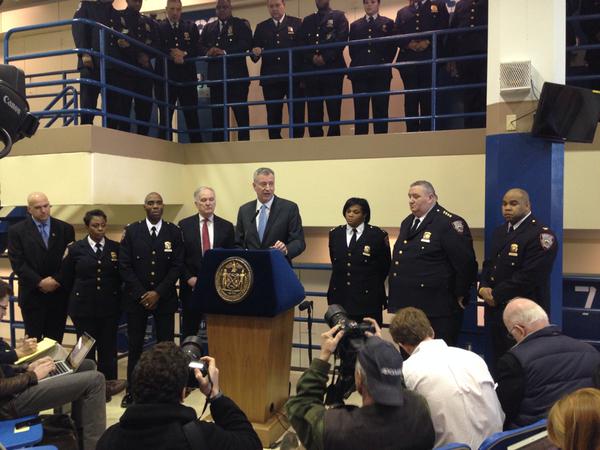
Mayor de Blasio at Rikers (photo: @MonicaCKlein)
After three years of volunteer service, I recently stepped down from the New York City Board of Correction, which is responsible for ensuring that all city jails, including Rikers Island, meet certain minimum standards regulating the care of inmates.
It wasn't the happiest experience I've ever had. While I was on the Board of Correction, Rikers Island became a topic of intense local and national concern. Thanks in no small part to intrepid reporting by Graham Rayman, Jake Pearson, Michael Winerip, Michael Schwirtz and others, there is now widespread agreement that Rikers Island requires significant reform.
One of the statistics we monitored at the Board of Correction is the use of force by correction officers. While I served on the Board, there were a number of horrific incidents where inmates were injured. In several cases, inmates died. Even though I have worked in criminal justice for more than 20 years, I found these incidents shocking and appalling.
On my tours of Rikers Island, I had the chance to meet numerous correction officers. I always sized them up, looking for signs of cruelty. To be honest, what I found more often were signs of compassion. Many (but by no means all) of the correction officers I met expressed real pride in their jobs and real concern for the inmates in their charge. Even in the most horrible of settings – and make no mistake, the jails on Rikers Island are horrible places to be – these officers were capable of small acts of kindness and understanding.
How do we square this reality with The New York Times reports of "medieval levels of violence" meted out with "startling ferocity" by guards at Rikers? Or to ask the question another way, how do we encourage more kindness and less brutality by correction officers?
I have come to the conclusion that the answer is not necessarily more rules or more scrutiny.
In truth, there is no shortage of oversight of Rikers. In addition to the New York City Board of Correction, there is the New York State Commission of Correction, the New York City Council, the media, the courts, and the U.S. Attorney's Office. And this doesn't even begin to list the advocacy groups that keep tabs on what happens on the Island.
Despite all of this, a recent Times headline reported a hard truth: "Even as Many Eyes Watch, Brutality at Rikers Island Persists."
There is an old business adage that "culture eats strategy for breakfast." I fear that the current approach to change on Rikers Island leaves the "deep-seated culture of violence" identified by U.S. Attorney Preet Bharara mostly untouched.
Any effort to change the culture on Rikers must reckon with the deteriorating physical plant, which is beyond antiquated. Even with the reductions in volume that we have seen over the past 20 years, there are still too many people on Rikers – the daily headcount is typically around 10,000 inmates. It is exceedingly difficult to manage this many people humanely in facilities that are falling apart. As the MacArthur Foundation and others have argued, we must explore ways to reduce the number of people in jail, particularly those who are detained pre-trial. And, as former NYC Correction Commissioner Marty Horn has said, we should be looking at options to close Rikers Island and create smaller, county-based facilities with modern amenities (like air conditioning).
Even as we attempt to reduce head counts and improve the physical environment, we should also be having an honest conversation about discretion. A generation ago in the seminal book Street-Level Bureaucracy, Michael Lipsky pointed out that the exercise of discretion is a critical dimension of the daily life of frontline government workers, be they police officers, social workers, teachers, or correction officers.
While we can and should develop baseline standards for correction officers, the truth is that it is impossible to create protocols for every situation that they will experience on the job – no matter how hard we try, there will always be room for officers to exercise discretion, for good or for ill.
Given this reality, we must work harder to create a clearer sense of mission at the Department of Correction. Rules cannot do this. As professor Mark Kleiman (channeling the spirit of James Q. Wilson) has written: "Organizations prize autonomy...Deprivation of autonomy tends to worsen morale and thus performance. The impulse to over-regulate the public sector is a destructive impulse."
In visiting Rikers Island, I never once felt I was in a place of "correction," where the dominant philosophy was one of rehabilitation. To change this will require a significant investment of energy, money, and time. This means taking unglamourous steps that may not yield dividends for years to come, including increasing the salaries of corrections officers, changing the union dynamic, raising hiring standards, investing in research to help promote a learning culture, and giving correction officers a meaningful voice in reform plans as a means of increasing their buy-in.
While many demand immediate change, the reality is that Mayor de Blasio inherited problems on Rikers Island that were decades in the making. We should be realistic about what his administration can accomplish in the short term – and encourage the formulation of a long-term plan that truly changes the culture of the institution.
***
Greg Berman is the Director of the Center for Court Innovation and author of Reducing Crime, Reducing Incarceration: Essays on Criminal Justice Innovation (Quid Pro Books).
***
Have an op-ed idea or submission for Gotham Gazette? E-mail editor Ben Max: This email address is being protected from spambots. You need JavaScript enabled to view it.
Citywide Rezoning Plan Would Benefit Developers, Hurt Neighborhoods
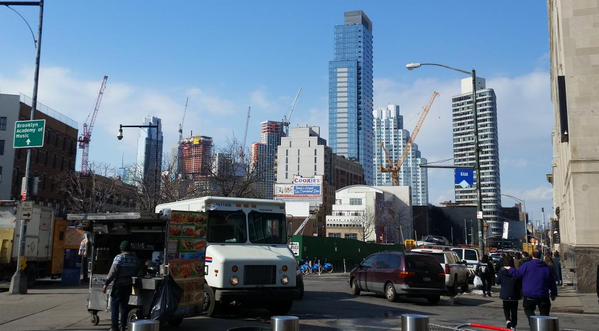
Cranes over Brooklyn (photo: Michael Flynn)
A citywide rezoning proposal quietly released by the de Blasio administration last month has begun the public review process. 'Zoning for Quality and Affordability' sounds like mom and apple pie, as it purports to make new housing less costly and meet higher standards. But a closer examination calls these premises into question. Big real estate, not average New Yorkers, would be the main beneficiary of some of the plan's key provisions, and its cost would be the undoing of neighborhood zoning protections years in the making.
The proposal is quite broad in its scope. But a central element is raising the allowable height of new development in "contextual zoning districts" -- areas where specific height limits and streetwall requirements help ensure that new buildings fit their context. These rules are meant to keep much of the "sore thumb" development we see around the city from cropping up in residential neighborhoods with strongly defined character, from the Lower East Side to Harlem, Crown Heights to Jackson Heights, the Village to Sunset Park.
Many of these height limits took years of effort by local communities to secure, and often involved compromises and trade-offs with the city and real estate interests to attain modest controls.
Now those rules would be upended, with the height caps lifted by as much as 20 to 30 percent, across the board.
As the plan's title implies, the rationale for these proposed changes are improvements in "quality and affordability," but neither seems likely to result from the current plan.
First, in many cases the proposed height limit increases would apply to purely market-rate housing. For example, in one of the more common contextual zoning districts, developers would automatically get to build about 20 percent taller than currently allowed for new luxury development. In the fraction of those districts where developers get more square feet if they reserve 20 percent of the units for affordable housing, there would be an additional 10 percent bump in the allowable height for such construction.
But even the height increase for developments that include 20 percent affordable housing raises serious questions. In existing contextual zoning districts such as the East Village, we have seen affordable housing included in some new developments built with the current, hard fought-for height limits, though not in every one. The City says higher height limits will mean more affordable units built, but the mixed results in places like the East Village don't offer any clear indication that this is so.
Including affordable units is currently optional in these zones, and this plan would not change that. It seems that the optional nature of the program, along with a variety of other factors, have a much bigger impact upon the number of affordable units built, rather than the height limits.
But for argument's sake, let's say raising height limits in contextual zones would increase participation in the 20 percent affordable housing program. Advocates for this approach point to the two areas of the city where significant numbers of affordable units have been produced through this program, West Chelsea/Hudson Yards and Williamsburg/Greenpoint. They have much looser height restrictions on new development and a significant number of their tidal wave of new, luxury developments include 20 percent affordable housing.
At the same time, though, in the ten years since that program has been implemented in those neighborhoods, they have seen a nearly unprecedented rise in rents and housing prices. In other words, in the two cases where this program has been most successful – where we have seen the highest rates of developers choosing to include 20 percent affordable housing in their new developments – we have also seen perhaps the most dramatic overall loss of affordability.
Is this the future we want? And is this not the inevitable result of tying the production of every new affordable apartment to four market-rate, super-luxury ones, which is enshrined in this proposal?
The other rationales for the increased height limits in the plan are equally dubious. The City claims current contextual zoning rules result in flat, boxy buildings; undesirable street-level ground floor apartments; and substandard floor-to-ceiling heights that discourage development. By lifting the overall height of buildings and loosening the contextual zones' streetwall requirements, the City claims more attractive and livable buildings that are cheaper to construct will result.
In fact, while some new buildings in contextual zones are mediocre in design, some are actually quite appealing – it really depends upon the architect and developer. But non-contextual zones, with no height limits or streetwall requirements, routinely see some of the most uninspiring, cringeworthy new designs in the city, poking a big hole in the "less restrictions equals better design" theory.
And as for the notion that current height limits are discouraging development or making for substandard apartments, one need only look at the flood of new construction in contextual zones from Bedford-Stuyvesant to Astoria, Park Slope to the Upper East Side. People are lining up to live there, and developers are making a hefty profit.
But perhaps not as hefty as they would like. Fewer restrictions on height, allowing grander floor-to-ceiling heights and apartments with more commanding views, would fetch developers even higher prices. But it certainly would not make these new apartments more affordable. And neighborhoods would pay the price with less light, air, and sky, and a loss of the character and scale they fought so hard to maintain.
The main beneficiaries of these aspects of the 'Zoning for Quality and Affordability' plan appear to be real estate interests, not those who care about quality design or affordable housing. It's likely no coincidence that these proposed changes are ones that deep-pocketed developers have sought for years. Now, wrapped in claims about quality and affordability, they finally have a chance to get them.
The mayor's 'Zoning for Quality and Affordability' plan is not without good points, and its stated goals are worthy of support. But substantial modifications are needed to protect neighborhood character and benefit average New Yorkers before it can live up to its lofty premise, and before it should be considered for adoption.
***
Andrew Berman is the Executive Director of the Greenwich Village Society for Historic Preservation
****
Have an op-ed idea or submission for Gotham Gazette? E-mail editor Ben Max: This email address is being protected from spambots. You need JavaScript enabled to view it.
Separating Fact from Fiction on the DREAM Act
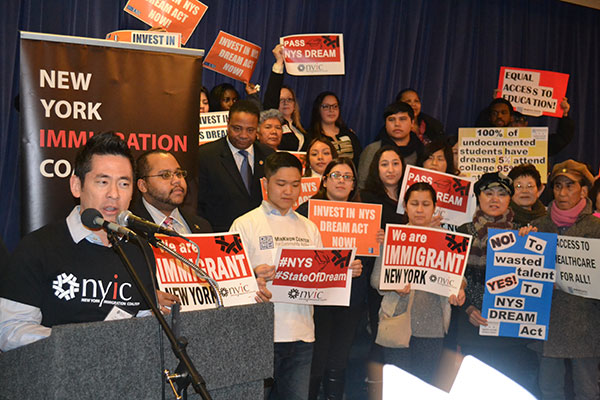
The author at a rally for the DREAM Act
The gridlocked Congress' failure to produce needed, overdue immigration reform prompted several states to create their own versions of the proposed federal DREAM Act, which would provide publicly financed college tuition aid to undocumented immigrants.
Texas, a red state; California, a blue state; and New Mexico, a purple state; each has adopted its own version of the DREAM Act.
In New York, the DREAM Act enjoys the support of editorial boards as varied in their opinions, politics, and geographical concerns as Newsday, the New York Post, Rochester Democrat and Chronicle, the New York Times, the Albany Times Union, and the New York Daily News.
So why did the New York DREAM Act go down in defeat—narrowly—in the Legislature last year? Mostly because of fear and anger stirred up by opponents through the spread of misinformation.
If New York is to enact the DREAM Act this year and make the commonsense investment in its workforce and future that editorial boards, elected officials, and New Yorkers across the state are calling for, we need to separate the fact from the fiction.
Fiction: The DREAM Act will take money away from students who were born in this country and give it to those who were not.
Fact: New York's Tuition Assistance Program (TAP) is an entitlement program. Each and every student who meets the TAP income eligibility and other requirements is entitled to financial aid—no matter what. The additional cost of providing TAP dollars to Dreamers is estimated to range between $17 million and $27 million, about a .00018% increase in the state budget.
Fiction: The DREAM Act will reward people who broke the law.
Fact: Punishing young people for something their parents did is not the American way. And let's not lose sight of the fact that what the parents of Dreamers are guilty of is wanting a better life for their children, like generations before them and generations to come.
Fiction: The DREAM Act doles out tax dollars to people who themselves don't pay taxes.
Fact: According to a study by the Institute on Taxation and Economic Policy, undocumented immigrants contributed an estimated $744,276,000 New York State taxes in 2010. At the federal level, the Social Security Administration each year keeps $6 billion to $7 billion in social security contributions from W-2s that cannot be matched with a correct social security number. The vast majority of that money comes from undocumented immigrants who are forbidden by law to access many of the most basic government services which they help fund.
And the Fiscal Policy Institute has calculated that bachelor's degree holders pay an additional $3,900 in annual state taxes, meaning that TAP funding for the undocumented would more than pay for itself within six years.
In other words, making college more affordable for all is a smart investment in workforce development and our state's future. The more educated our workforce, the better it is for our economy - and Dreamers will most certainly be part of our workforce. They don't know any country other than the United States. Their futures are here.
Let's follow the bipartisan example of the five states that have already passed a DREAM Act. Let's come together in New York and make the DREAM Act a reality.
***
by Steven Choi is Executive Director of New York Immigration Coalition (on Twitter @stevechoinyic & @thenyic).
***
Have an op-ed idea or submission for Gotham Gazette? E-mail editor Ben Max: This email address is being protected from spambots. You need JavaScript enabled to view it.
Our Time in Selma
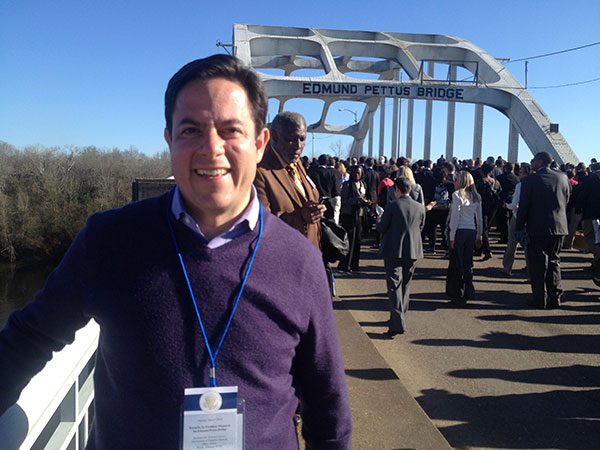
Council Member Dan Garodnick, in Selma
Last weekend, my wife Zoe and I had the privilege of going to Alabama to trace some steps of the foot soldiers of the Civil Rights Movement as part of the jubilee celebration of the 1965 march from Selma to Montgomery. We were honored to pay respect to those who gave so much of themselves in pursuit of justice and who changed American history in the process. We immersed ourselves in that history as part of a group organized by the Faith and Politics Institute, and came away with an even deeper resolve to further their work.
We sat in the 16th Street Baptist Church in Birmingham, where a bomb exploded over 50 years ago, tragically stealing the lives of four young black girls, their futures taken from them while they were changing into their choir robes.
We visited Brown Chapel A.M.E. Church in Selma, where ordinary Americans gathered to learn the tactics of nonviolence, and steeled themselves for the unknown as they endeavored to march 55 miles to Montgomery to deliver a clear message to the Alabama Governor, and ultimately to the world.
And we went to the Edmund Pettus Bridge, the site of Bloody Sunday -- where so many of them were brutally attacked by an angry mob of police -- precisely a half-century ago.
We heard Congressman John Lewis, leader of the first march in Selma, describe being beaten unconscious on that bridge as he and his compatriots attempted to march quietly, two-by-two in support of their fundamental rights.
He wasn't doing it to be a hero. He was doing it because of a deeply held belief in the equality of man, and with his faith that God would protect him from harm. Indeed, while he might have anticipated a night in jail - and had stocked his backpack with an apple, toothbrush and book for that eventuality - he didn't actually expect the march to result in violence, which it did, at the hands of billy clubs, horse hooves, and tear gas. He does not remember how he got off the bridge.
We admired his bravery in moving forward, as the police in Selma had put out a call to a mob of young white men to serve as "deputies" to help them stop this march from proceeding.
We heard him tell the story about the man who visited his congressional office in 2009, who had assaulted him years earlier, and asked for his forgiveness. Without an ounce of bitterness or regret, John Lewis forgave him and "called him my brother."

Council Member Garodnick with his wife, Zoe, and Rep. John Lewis
Among other giants from the movement, we spent time with Juanita Abernathy, the widow of Ralph Abernathy, who never missed a march.
We heard from the daughter of Viola Liuzzo, a mother of five from Detroit who heeded Dr. Martin Luther King's call to come to Selma, and who was murdered when her car was run off the road by the Ku Klux Klan. When asked why her mother went to Selma, she responded: "The real question is: Why didn't everyone go to Selma?"
And of course, we were moved to see John Lewis and President Barack Obama embrace at the foot of the Edmund Pettus Bridge. The president, whose very presence next to that bridge spoke volumes, captured the spirit of America when he referred to the courage of the foot soldiers, and asked: "What could be more American than what happened in this place?" He added: "We were born of change."
The most important takeaway for me: while times have changed significantly, the work of Selma is not complete. There is so much more to do.
On police-community relations, an issue that animated much of this past year, President Obama reminded us that the citizens of Ferguson, New York, and Cleveland "just want the same thing young people here marched for – the protection of the law." At the same time, he cautioned against marginalizing our police, as they are "members of the very communities they risk their lives to protect." This conversation will appropriately continue in New York, and all across this country, and in the tradition of Dr. King, we must do so with peace and civility in our hearts.
Significantly, our voting rights themselves are under attack. The Supreme Court recently struck down key portions of the Voting Rights Act, which gave the federal government the chance to "pre-clear" voting rules in areas with historic discrimination. At the same time, states have been enacting laws designed to make it even tougher for people to vote. All of this in a country that already has among the lowest voting rates among free nations. Those facts are beyond disappointing; they are actually disrespectful to those who gave so much to solidify basic rights for all Americans.
Unfortunately, Congress has not yet acted to fix what the Court has done.
The Voting Rights Act was, as President Obama said, a "crowning achievement of our democracy" and it is now "subject to partisan rancor." That cannot be. Re-activating key portions of the Voting Rights Act is the right way to honor those brave men and women who marched in 1965, and Congress should act without delay. If you agree, you can add your voice here.
And of course, right here in New York, we need to lead on ballot access issues. We should take steps to allow for early voting and same-day registration, as well as no-excuse absentee voting and instant runoffs - all ways to make it easier for people to participate in the electoral process. But that alone won't solve our voting issues. People still need to see a reason to come out and cast a ballot. In our last statewide election in New York, a pathetic 28.8 percent of eligible voters turned out to the polls. Scandal, negative campaigning, and general frustration are contributing factors – and we need to turn the ship around.
The visit to Alabama was inspiring and humbling at the same time. We must honor the foot soldiers of the Civil Rights Movement by giving people a reason to participate, and by defending and strengthening the rights that they fought so hard to achieve.
***
Dan Garodnick is a member of the New York City Council, representing the fourth district, in Manhattan.
***
Have an op-ed idea or submission for Gotham Gazette? E-mail editor Ben Max: This email address is being protected from spambots. You need JavaScript enabled to view it.
Dear Speaker Heastie: Support for your DREAM Act push is strong
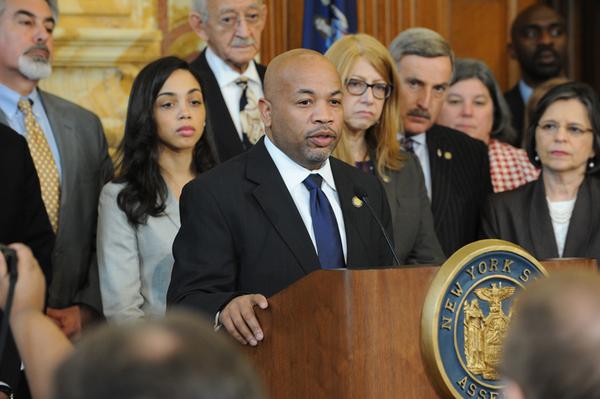
Speaker Heastie (photo: Lori Van Buren)
Dear Speaker Carl Heastie:
A few weeks ago, you shared your initial priorities as the new Assembly Speaker. It was refreshing to see you focus on expanding access to opportunity for all of New York's youth, including the thousands of undocumented students who deserve a fair chance at going to college. We, the College Access Consortium of New York (CACNY), a network of over 100 professionals representing community-based organizations, colleges, and secondary schools, stand by you in fighting for the NY DREAM Act this session.
The American Dream is based upon the principle of equal opportunity for all. However, making that dream a reality for thousands of first generation college students cannot wait another year. According to USA Today, of the more than five million first generation low-income students, only 11 percent will earn a college degree.
In May of 2011 the NY DREAM Act was introduced to level the playing field for the children of undocumented immigrants. This idea builds upon bipartisan legislation passed over a decade ago by Governor Pataki that granted in-state tuition rates to undocumented youth. At its core, the NY DREAM Act is key for thousands of youth across the state to obtain post-secondary opportunities by allowing them access to state financial aid, just like any other student proudly walking across the stage at their high school graduation or dancing at their senior prom.
As college access and success professionals, members of the CACNY community know that unequal access to the Tuition Assistance Program and other forms of state aid can be the proverbial 'straw that breaks the camel's back,' preventing an otherwise willing and capable student from accessing and succeeding in college and subsequently contributing to the workforce of our state.
As a fellow New York City native, I have seen first-hand the negative educational and economic impact that delaying the NY DREAM Act for four years has had on our communities. In solidarity with our fellow CACNY members, we express our collective support and desire that your efforts this year will yield a different outcome.
***
by Felipe Ayala Jr., Chair of the College Access Consortium of New York
***
Have an op-ed idea or submission for Gotham Gazette? E-mail editor Ben Max: This email address is being protected from spambots. You need JavaScript enabled to view it.
Real Answers to Improve Diversity at the Specialized High Schools

Brooklyn Tech HS (photo via school website)
Critics of the Specialized High School Admissions Test as the sole criteria for admission to Brooklyn Tech, Stuyvesant, Bronx Science and five other schools continue to lament the low admissions rates of African-American and Latino students. While they do so, two remarkable developments occurred last week when the latest admission results were announced.
First, NYU's Research Alliance for New York City Schools released a significant new research report. It shows many of the changes being urged on elected policy makers - such as using state assessment test scores, grades, and attendance - either would result in little change in the admissions rates for these groups or would actually result in fewer black and more white students being offered admission.
The study states that the only way to make dramatic demographic change through altering the admissions criteria was to eliminate the test and substitute guaranteed admission to the top ten percent of students at each middle school. But it makes clear that this would come at the significant cost of lowering the academic preparation of the student body to do the rigorous coursework that make the specialized test-in schools the turbo-charged engines of advancement to the best colleges for the children of New York City's working class, poor, and immigrant families. (Two-thirds of the city public school graduates attending Harvard, Princeton, or Yale graduate from only three high schools - Brooklyn Tech, Stuyvesant, and Bronx Science - where 50% of the combined student body qualifies for free or subsidized lunch, a measure of poverty.)
Given this dilemma, the NYU Research Alliance urged policy makers to consider better outreach to underrepresented communities to raise the number of high-performing students who sit for the test and offer better free test prep to ensure they are prepared to do well on the test. That is the same prescription advocated by alumni when we have urged lawmakers not to change state law mandating the sole use of the SHSAT for admissions. That state law covers Brooklyn Tech, Stuyvesant and Bronx Science. Five additional specialized high schools created administratively by the old Board of Education also use the test to determine admissions.
The other relevant development last week is the wildly positive demographic results obtained at Brooklyn Tech – where I graduated in 1970 and now head the Alumni Foundation – resulting from innovative efforts made recently by the school and its alumni. Improvements in the numbers of African-American and Latino students being admitted to the school show that change is possible without moving away from the SHSAT.
What did Tech and its alumni do? Quite a bit: A consistent outreach effort was undertaken, targeted at many Brooklyn middle schools sending few or no students to Tech. The school increased the number of tours offered to prospective applicants. With the assistance of the Alumni Foundation, the school also developed a "Tech in the Middle" project which brought middle school classes into the building for special sessions and tours which enabled teachers to speak about the opportunities created by getting a STEM (science, technology, engineering, math) education. Alumni went to Community Education Council meetings to speak with principals and parents about the school. Seventh grade students visiting Brooklyn Tech were given copies of the Specialized High Schools Student Handbook, which means information about the test being distributed to students a year in advance of their sitting for the exam. Through the efforts of the Alumni Foundation, a print and television public relations campaign was rolled out highlighting positive news about STEM education and the school.
In partnership with the Alumni Foundation and National Grid New York, which is led by Ken Daly, a Tech graduate, and has employed dozens of diverse Tech graduates, the school announced a pilot STEM pipeline program aimed at high-achieving middle school students to encourage them to study STEM subjects and pursue energy carriers.
National Grid is dedicated to developing the next generation of science, energy, and environmental leaders to develop sustainable energy solutions and tackle climate change. National Grid pledged $300,000 for this effort and the Alumni Foundation underwrote the costs of providing free test prep to the group through the Science Schools Initiative. This program is different than any other because it aims to get kids excited about future careers after studying STEM while also preparing them for the test. In addition, we conducted a special high school admissions session with the parents of these students to teach them about the process - parental buy-in is very important to the success of the program.
The results of the first cohort taking the test have been spectacular: 87 percent were offered admission to a specialized high school. Of the 30 students completing the year-long program who took the SHSAT, 16 were admitted to Brooklyn Tech and 10 to Stuyvesant. (The remaining four will also be going to great high schools, one each to Beacon, Bard, Bedford Academy, and Brooklyn High School for the Arts.)
The demographic results were also encouraging, with 50 percent of the students admitted to Tech being African-American or Latino, and 62 percent being female. Our program also managed to boost Stuyvesant's demographic admissions statistics with two of the ten black students admitted this year having come through our program.
While offers of admission increased overall at Brooklyn Tech by 6 percent, offers of admission to African-American and Latino students surged by 12 percent and 22 percent, respectively, when compared to the year before. Over 300 African-American and Latino students were offered admission to Brooklyn Tech this year, reversing a downward trend of many years.
So what does this mean for policy makers? It means that significant efforts can be successfully undertaken to improve the admissions of African-American and Latino students without sacrificing the educational opportunity guaranteed by use of the test as the sole criteria for admissions. Thought should be given to having public monies intelligently spent to scale our STEM pipeline program and also bring it to Stuyvesant and Bronx Science and the other specialized science high schools.
We recognize that other efforts also need to be made to improve diversity, promote fairness, and maintain merit at these schools. Better and more enriched educational opportunities must be made available in the elementary and middle schools serving predominantly African-American and Latino communities. A refitted Discovery Program can significantly increase the numbers of these students at all the specialized schools by redefining eligibility for the program to include attending an underperforming middle school. Discovery offers students just missing the cutoff score for admissions a second chance to qualify through summer courses preparing them to meet the challenges posed by the rigorous curriculum of the specialized schools. The program once sent hundreds of eighth-graders to the specialized high schools, but has since fallen into disuse.
Other types of efforts could be made to improve the situation at little cost to the public. Thirty minutes could be added to the test to permit students not taking test prep the additional time needed to complete all the questions on the exam, for example. We want to see a practice test administered in the seventh grade to enable children to know a year in advance what they need to study to do well on the actual exam.
We have fought to keep "the test" as the sole criteria for admission because proposals to add additional criteria pose ineffective answers to the problem of declining diversity at these schools and risk destroying what is good and unique about them.
Those of us who benefited from the rigorous education provided by the specialized high schools agree that the lack of diversity is a problem the city should address, but not through abandoning the meritocratic test as the sole criterion for admission. The challenge the city faces is to identify high-performing students at younger ages – perhaps through their scores on standardized state tests – and nurture those children to prepare them for the rigors of the SHSAT and the schools' curriculum.
There are more than 700 programs at 400 high schools in the public school system, and there ought to be room for a handful of test-in only schools just as there needs to be schools using multiple criteria for admissions decisions. There are real answers that will help diversify the specialized schools. The Department of Education and our elected officials need to consider and implement them.
***
Larry Cary is the president of the Brooklyn Tech Alumni Foundation and the chair of the Coalition of Specialized High Schools Alumni Organizations.
***
Have an op-ed idea or submission for Gotham Gazette? E-mail editor Ben Max: This email address is being protected from spambots. You need JavaScript enabled to view it.
The Perfect Parking Spot for Congestion Pricing

(photo: Mario Tama/Getty Images)
New York City can achieve the goals of a long-vanquished congestion pricing plan through the management of its own parking property – all without making a single call to Albany.
New York is famously a city of contradictions and contrasts. Perhaps the most fundamental duality is its status among the world's most important cities and the fact that it yields much of its own governance to a hamlet up the Hudson River. Battling Albany is the oldest pastime in New York City politics. However, as Mayor Bill de Blasio continues to lobby for home rule and maneuver legislative alternatives, there already exists a latent opportunity to turn around one of the major defeats of the previous mayoral administration: congestion pricing.
A rare crushing defeat of the Bloomberg Administration, congestion pricing is a policy that attempts to lessen congestion in central urban areas by charging a fee to enter a demarcated zone. Following the lead of other major world cities, Mayor Michael Bloomberg sought to enact a congestion pricing plan in 2008, but Albany brought the mayor's plans to a halt when Speaker Sheldon Silver could not secure enough Democratic votes to bring the plan to the floor of the Assembly - where Democrats have long-held a wide majority - before the legislative session expired.
Other professionals and advocates have renewed efforts at securing more measured transportation policy from Albany. But in the meantime, New York City can pursue many of the same goals of congestion pricing through the administration of its own property: parking spaces.
At its core, congestion pricing operates with one simple mechanism: attaching a higher cost to the activity of driving into the city center. Parking is an inherent cost associated with driving – and not just a monetary one. While the City may not have comprehensive power to demarcate congestion zones or raise tolls on Metropolitan Transit Authority (MTA) bridges and tunnels, parking is still inevitable at the end of every trip, and can serve as an effective proxy for raising prices on the activity of driving.
There are three main ways that New York City can lower congestion, stop subsidizing personal car ownership, and raise revenue through the management of its own parking spaces. While I go into further detail on all these reasons, and the data behind them, in a white paper published by the Roosevelt Institute, here is how the City should do so in brief:
Raise parking meter rates, and ideally enact "smart" demand-responsive pricing systems
In New York City, parking simply remains far too cheap, way below market price for how valuable a resource it is. While the rate for one hour of parking in a private garage in Manhattan can easily hit $30, the most expensive street parking in the city is $3.50 an hour. This discrepancy encourages drivers to cruise around in search of dirt-cheap street parking, and constitutes a surprisingly large portion of overall congestion. Correcting the underpricing of metered street parking has proven effective at removing this particular source of congestion in other cities, in addition to raising revenues.
The most thorough manifestation of this concept is the dynamic pricing system put into effect in San Francisco, where a "smart" grid of electronic meters allows prices to be changed based on demand in nearly real-time. New York City already administers a less precise, lower tech version of this with its "Park SMART NYC" program, which raises prices during business hours based on demand in certain neighborhoods. The Department of Transportation should expand such pricing schemes until installing the kind of infrastructure in San Francisco is viable.
Residential parking permits
While metered parking is a great illustration of how parking is subject to supply and demand pressures, it ultimately constitutes a very small percentage of all parking spaces in New York City – by some estimates, a maximum of 2 percent. The vast majority of the parking stock is completely free parking spaces on residential side streets. Such an egregious underpricing of residential spaces represents a de facto subsidy for personal car ownership within the city. In addition to removing this subsidy, a residential parking permit would raise revenue from an untapped source of rentable city property, and offers residents increased certainty that a parking space will be available when they return home – a crucial factor that helps gain support from residents.
Dedicating public spaces for car-sharing vehicles
A final solution involves careful public-private partnerships to dedicate on-street parking spaces for the exclusive use of vehicles in a car-sharing service, such as ZipCar or Cars2Go. Car-sharing services provide many benefits that have already proven popular in New York. For those who cannot afford the high costs of purchasing, insuring, and fueling a car, paying a small subscription rate and hourly fee for when they actually use a car is a viable alternative. Car-sharing can also ease the decision to move to a carless lifestyle - which should be encouraged - by providing an alternative for bigger trips such as errands to big box stores or moving.
Traffic congestion remains a critical problem in New York City. In addition to the dangers of pedestrian casualties, environmental emissions, and low quality public space resulting from car-centric design, traffic congestion is estimated to have cost New York City $1.9 billion in logistical, inventory, and personnel costs, and up to $4.6 billion in unrealized business revenue.
A comprehensive congestion pricing plan should remain a goal for anyone interested in a better New York City. But while Albany continues to seethe and combat its own corruption, there is nothing holding back a self-described progressive mayoral administration and City Council from managing the city's own public space in a smarter way.
***
Brit Byrd is a Senior Fellow at the Roosevelt Institute | Campus Network and a Columbia University student.
***
Have an op-ed idea or submission for Gotham Gazette? E-mail editor Ben Max: This email address is being protected from spambots. You need JavaScript enabled to view it.
Governor’s Student Loan Relief Plan Helps Less Than One Percent
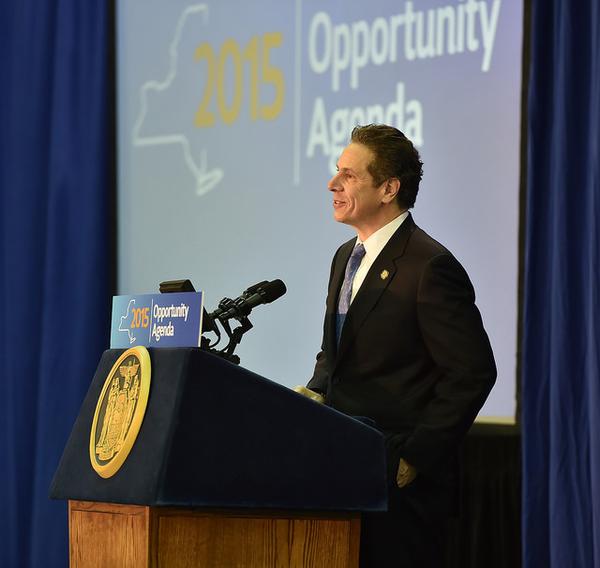
Governor Cuomo (photo: @NYGovCuomo)
Just over 2.8 million New Yorkers hold nearly $74 billion in student loan debt. Governor Cuomo’s Get on Your Feet Loan Forgiveness Program wouldn’t even help one percent of them with their debt, even when fully phased in.
The proposal would apply to New York State residents who graduate from college in the state, continue to live here, and make less than $50,000 per year. It would allow those New Yorkers to pay nothing on their student loans for the first two years out of school. Instead, the State would make loan payments so long as debt holders are participating in a federal program - the Pay As You Earn (PAYE) income-based loan repayment program – an option that forgives the remainder of a federal loan after 20 years of consecutive monthly on-time payments or 10 years if you're enrolled in the Public Service Loan Forgiveness Program.
It’s great that Governor Cuomo is thinking about the student debt crisis by helping a few recent graduates get on their feet. However, without addressing the high and rising cost of going to college, which is the root cause of high and rising student debt levels, debt will continue to cripple an entire generation’s ability to fight ever-growing inequality. Some are referring to bleak employment prospects, unemployment rates, and low wages for young people as the “Lost Decade” effect.
This unprecedented student debt crisis continues to impact economic markets like housing. According to a report by Young Invincibles, the average single student debtor is likely ineligible for a typical home mortgage due to their debt-to-income ratio.
It’s important to note that this wasn’t always the case. Prior to the Great Recession, homeownership rates of those with a history of student debt were substantially higher than those without. This is because earning potential is higher for those with degrees. However, despite it being a buyer’s market, student loan debtors are still less likely than non-debtors to buy a home.
The biggest growth in student loans came in the past decade, as student debt rose an average of 14 percent per year from $364 billion in 2004 to over $1 trillion today, according to the New York Fed. To be fair, total student debt has ballooned in part because more people are going to college and therefore taking out student loans. It’s good that more people are earning college degrees. However, that’s not the only contributor to the ballooning of student debt. The cost of getting a bachelor’s degree is 12 times higher than it was 35 years ago, far outpacing medical care, housing, and all other commodities – and that’s accounting for inflation.
New York is no outlier. State tuition has increased by nearly 130 percent at New York’s public four-year colleges over the last two decades. Tuition at the City University of New York (CUNY), which was once free for all city residents, will increase nearly 60 percent from 2008 to 2016 alone. Meanwhile the state’s Tuition Assistance Program (TAP) remains grossly inadequate. This is why 60 percent of New Yorkers graduate owing student loan debt with an average amount of $26,381.
To seriously address the student debt crisis in New York, Governor Cuomo must:
-
Inject general resources into SUNY and CUNY so the universities can rely less on tuition revenue. Decades of disinvestment has made higher education either inaccessible for many or comes with an unsustainable and long-lasting cost.
-
Rollback the annual tuition increases made since the Great Recession. Raising tuition through a recession and the years that followed unfairly burdened families during difficult times while also reducing the multiplier effect we could be realizing if dollars weren’t being drained into paying high tuition and then paying off student loans;
-
Bring TAP into the 21st century through a number of common sense reforms. This includes streamlining the rules of the program to open access to students in need and increasing the maximum award to $6,500 to keep up with rising costs associated with going to college.
-
Integrate rewarding and incentive-driven loan forgiveness programs in all economic development initiatives to help address the more than 2.8 million state residents with student loan debt. This includes expanding the reach of initiatives like the NY SUNY 2020 Grant Challenge Program, STARTUP NY, and others to reduce and forgive the student loan debt of employees as a baseline of doing business in the state and benefiting from these very rewarding programs.
The shared value in the above four policies that the state requires is simple: an increase in the capital that can be reinvested into the New York economy in other ways by reducing the monthly and overall amount of student debt that New Yorkers are paying.
It’s time for the governor and state policy-makers to start thinking differently about higher education and student debt. Most of the conversations happening around student debt policy don’t actually reduce payments or forgive debt. Instead they make loans cheaper or easier to repay - this type of thinking will only further fortify the crisis that is already having long-term negative effects on millions of people and the American economy.
But, implementing policies that reduce debt owed and forgive total debt will dig us out of this hole, and propel us into a brighter economic future.
***
Kevin Stump is Leadership Director at Roosevelt Institute | Campus Network
***
Have an op-ed idea or submission for Gotham Gazette? E-mail editor Ben Max: This email address is being protected from spambots. You need JavaScript enabled to view it.
